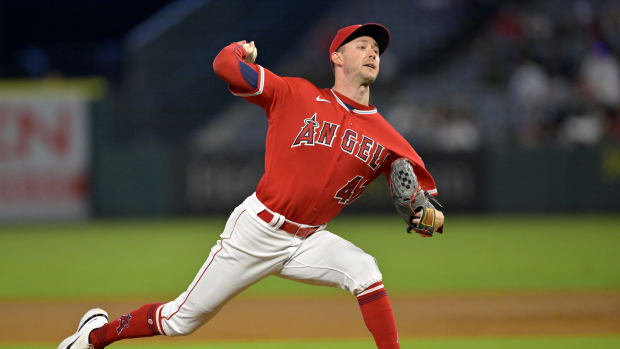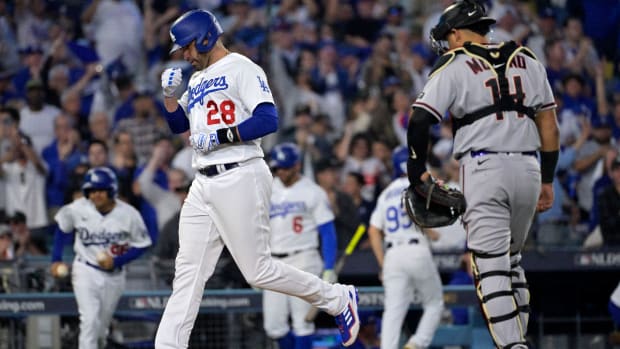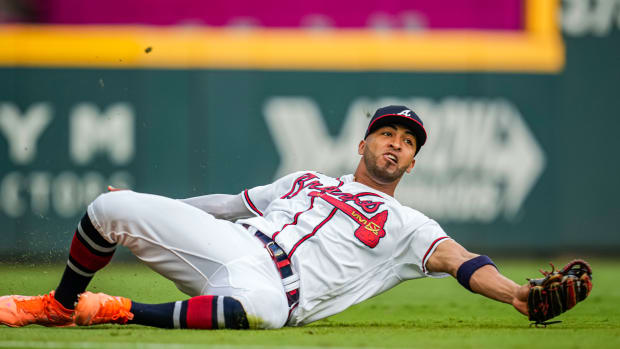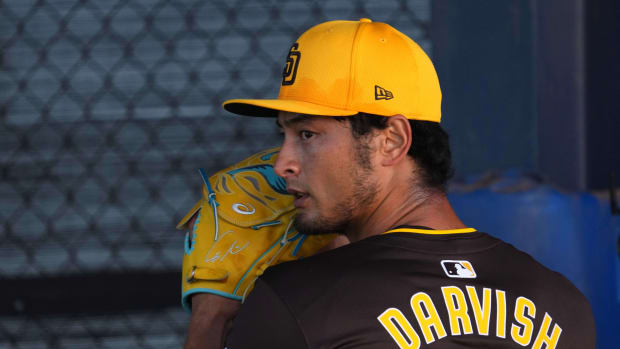NL West Hot Stove Preview
2007 Record: 90-72, 1st in NL West2007 Attendance: 2.3 million, 12th in National League2007 Payroll: $52 million, 26th in baseballKey Free Agents (2007)RHP Livan Hernandez RHP Bob Wickman1B-B Tony ClarkKey Free Agents (2008)2B-S Orlando HudsonLHP Randy Johnson RHP Juan Cruz RHP Brandon LyonKey-Long Term CommitmentsRHP Brandon Webb; $6.0m/year through 2009, plus 2010 club optionLF-R Eric Byrnes $10m/year through 2010LHP Doug Davis, $8.25m/year through 20093B Chad Tracy, $4.25m/year through 2009, plus 2010 club optionKey Ready-Now YoungstersOF-R Justin UptonOF-R Carlos QuentinINF-R Mark ReynoldsINF-S Alberto CallaspoC-L Miguel MonteroRHP Max ScherzerRHP Yusmeiro PetitRHP Sutin NippertLHP Dana EvelandNeeds: 1. One, maybe two quality SP, 2. Big-impact bat
What They Should Do:Weak Buy. There are a couple of countervailing trends to consider. First, as we've been reminded many times, this was a club that scored more runs than it allowed; if you simulated the past season a million times, the 2007 Diamondbacks would usually have finished closer to .500 than to 90 wins. Second, the bullpen isn't quite as good as advertised, since you had a lot of guys who compiled great ERAs on the back of average peripherals. On the other hand, the core positional talent is remarkably young and played better down the stretch, and the D'backs will have several assets coming back into play that they couldn't showcase in October, including Hudson, Johnson and Tracy. If it did literally nothing this winter Arizona would most likely field an 85-win club.
That is, of course, right at the range where adding a little bit of talent can go a long way, since there are a tremendous number of National League teams who figure to be in the same territory. And there's an obvious place to upgrade in the starting pitching department; Webb, Davis, Micah Owings and Johnson are a credible front four, but there's a big drop-off after that (plus, there's no guarantee that Johnson will pitch the entire season). One intriguing fit could be Greg Maddux, if the Padres do not pick up his option; he's still a groundball pitcher and could take advantage of Hudson's vacuum-like defense at second base. Otherwise most of the alternatives require use of the trade market. Nick Piecoro mentions Cliff Lee, Ervin Santana and Daniel Cabrera as possible alternatives. All of those make sense, particularly the latter two, and the Diamondbacks have some excess assets such as Tracy and Quentin to work from.
What They Will Do:Weak Buy. I expect the Diamondbacks to adopt largely this philosophy, but it might he harder than they recognize to get full value for pieces like Quentin.
2007 Record: 90-73, 2nd in NL West2007 Attendance: 2.4 million, 11th in National League2007 Payroll: $54 million, 25th in baseballKey Free Agents (2007)C-R Yorvit Torrealba2B-S Kazuo MatsuiRHP Josh FoggRHP Rodrigo LopezRHP Matt HergesRHP Jorge Julio RHP Jeremy AffeldtRHP LaTroy Hawkins (mutual option declined)Key Free Agents (2008)LHP Brian FuentesRHP Aaron Cook (club option)2B-R Jamey Carroll (club option)Key Long-Term Commitments1B-L Todd Helton, $17.2m/year through 2011, plus 2012 club optionKey Ready-Now Youngsters3B-L Ian StewartLHP Franklin MoralesRHP Ubaldo JimenezRHP Juan MorilloRHP Jason HirshRHP Taylor BuchholzRHP Alberto AriasC-R Chris IannettaOF-L Seth SmithOF-R Jeff BakerNeeds: 1. Second Starter; 2. 2B; 3. bullpen depth to replace free agent departures; 4. C, possibly
What They Should Do:Weak Buy. There is no doubt that the Rockies' run to the World Series has massively increased the credibility of the franchise, and attendance should approach the 3 million mark next year at Coors Field. Still, if the Rockies want to create some long-term afterglow rather become a footnote, they're going to need to improve the roster. The Rockies really only have a league-average offense relative to their park, and we saw in the World Series how the starting rotation can be exposed. And there are no fewer than four potential free agent in the bullpen. With the Diamondbacks on the rise, and the Dodgers likely to commit significant money to free agents, there is real danger that this team falls back below the .500 mark if they aren't fairly aggressive this winter.
One potential starting point would be trading third baseman Garrett Atkins for a starting pitcher, and allowing Ian Stewart to graduate to the position. This is not as much of a drop-off as you might think considering that Stewart is a significantly better defensive player, and the market for Atkins should be fairly robust given that several big-market suitors will come up short in the A-Rod derby. I also see no particular reason for the Rockies to break the bank for Torrealba, who had just a .235 EqA last season; I would rather give the job to Iannetta or pursue a higher-impact free agent. And I would devote $10-$12 million to the bullpen, preferring to re-sign my own guys because I know that they're comfortable in Coors.
What They Will Do:Hold. We've said it before: Teams that exceed expectations tend to keep everything in place, and in fact that's exactly what Charlie Monfort is saying -- "We'll keep the same team intact" is the headline on this MLB.com article. This is likely to be one of the bigger misplays of the off-season.
2007 Record: 89-74, 3rd in NL West2007 Attendance: 2.8 million, 9th in National League2007 Payroll: $58 million, 24th in baseballKey Free Agents (2007)OF-R Mike CameronOF-S Milton Bradley2B-R Marcus GilesC-R Michael BarrettRHP Doug BrocailINF-B Geoff BlumRHP Greg Maddux (mutual option)RHP Brett Tomko (club option)UTIL-L Rob Mackowiak (club option)Key Free Agents (2008)RHP Trevor Hoffman3B Morgan EnsbergRHP Jake Peavy (club option)RF-L Brian Giles (club option)Key Long-Term CommitmentsLHP Chris Young, $4.4m/year through 2010, plus 2011 club option1B Adrian Gonzalez, $2.8m/year through 2010, plus 2011 club optionKey Ready-Now Youngsters3B-S Chase Headley2B-R Matt AntonelliRHP Tim StaufferRHP Jack CasselNeeds: 1. CF, 2. RF, 3. Fourth starter; 4. 2B
What They Should Do:Strong Buy. There's been almost zero noise out of San Diego since the Padres turned a virtual lock on a playoff spot into an asterisk, and you wonder if Kevin Towers isn't a little bit shellshocked. Although his Padres managed to build a contender without lavishing extravagant contracts on free agents, this was nevertheless a team designed to win in 2008, as contracts for three or four key regulars are all coming off the books. The flip side of Towers' restraint, however, is that there should now be some money left in the till to pursue free agents.
The Padres' infield is largely set. In the long-run, the group is Headley, Khalil Greene, Antonelli and Gonzalez. Kevin Kouzmanoff will hold Headley off for no longer than one more season; after that the Padres will have to figure out whether Kouz hits enough to warrant a move to a corner outfield position. With Marcus Giles gone there's a chance that Antonelli could make the club out of spring training; otherwise the Padres will be looking at a Tadahito Iguchi-type one-year fix. The pitching should continue to be an asset, though it's a little top-heavy; the Padres should accept Maddux' option and look to add a No. 4 starter, perhaps a flyball pitcher such as Eric Milton, who wouldn't work in most other parks.
But the big decisions are in the outfield, where there's neither much present day talent nor much on the farm. From the following group the Padres need to sign at least one and quite possibly two players: Barry Bonds, who could thrive in San Diego's low-key media environment; Kosuke Fukudome, who has already been linked with the Padres; Torii Hunter, who will require a lot of money but provides a lot of marginal gain in Petco's large outfield; Andruw Jones, who is closer to Hunter in reality than in perception; and Aaron Rowand, for whom largely the same is true.
What They Will Do:Weak Buy. The Padres' problems in the outfield coincide very well with what's available in the free-agent market, and it's hard to run though this winter's scenarios without having at least one of those big talents ending up in San Diego.
2007 Record: 82-80, 4th in NL West2007 Attendance: 3.9 million, 1st in National League2007 Payroll: $108 million, 6th in baseballKey Free Agents (2007)LF-L Luis GonzalezLHP David WellsRHP Rudy Seanez3B-R Shea HillenbrandC-R Mike Lieberthal2B-R Jeff Kent (club option)LHP Randy Wolf (club option)Key Free Agents (2008)SS-S Rafael FurcalRHP Derek LoweINF Nomar GarciaparraLHP Joe Beimel LHP Mark HendricksonRHP Brad Penny (club option)RHP Esteban Loaiza (club option)Key Long-Term CommitmentsRHP Jason Schmidt, $12m/year through 2009CF-L Juan Pierre, $9.1m/year through 2011Key Ready-Now YoungstersOF-R Matt Kemp1B-L James Loney3B-R Andy LaRocheSS-R Chin-Lung HuLHP Clayton KershawRHP Jonathan MeloanINF-S Tony AbreuNeeds: 1. SP depth, 2. CF
What They Should Do:Hold. Play. The. Kids. The Dodgers simply need to deploy their existing assets correctly, rather than seek help from elsewhere. To get a bit more specific about it, next year's lineup should look as follows:
That group would be significantly better than league average at two positions (C, 2B), slightly better than league average at three positions (SS, LF and probably 1B), about league average in RF, and slightly below league average at CF and 3B (though not for long in LaRoche's case, especially with Nomar Garciaparra serving as his caddy). Overall it's one of the better position-player groups in the league. So then you take the money you're saving yourself on Luis Gonzalez and spend it on a mid-level starting pitcher to round out a rotation of Penny, Lowe, Schmidt and Chad Billingsley. Coupled with the great one-two punch in the bullpen, that's also an above-average group. That's it. You're done. You've spent next to nothing -- and you still have a potential pennant winner on your hands. It looks like about an 88-win core that can creep into the 90s if the veterans stay healthy.
What They Will Do:Strong Buy. There is no bigger disconnect in baseball than the Dodgers' ability to develop talent and the front office's lack of appreciation for that talent. Kemp is someone that they should be thrilled to have in their lineup for the next six years. LaRoche's time is now. So is Chin-Lung Hu's, and the Dodgers should consider trading Furcal to make way for him.
Instead, all rumors are that Ned Colletti's compass is pointed in the opposite direction. What I envision happening is something like the following: Kemp or LaRoche are included in a deal for a premium starting pitcher. And then -- guess what -- you do have a hole at LF or 3B, and you do need to work the free-agent market to repair it. But it isn't a hole that existed before; it's one that you've created. The behavior is literally almost pathological, a kind of Munchausen by Proxy Syndrome, in which Colletti seems determined to make the Dodgers sick so that he can make them well again. Playing the kids -- these talented kids from your farm system that embody everything that used to be called the Dodger Way -- well, that's just too darn obvious.
If the Dodgers feel like they have to have a 94-win club instead of an 88-win club -- and there's no reason they should feel that way after drawing almost 4 million fans last year -- there are still a couple ways they could accomplish this. For instance, beat Curt Schilling's second-best offer by 30 percent, which probably means something like $18 million. By definition, you're overpaying, but the magnitude of the mistake is much, much smaller than trading Kershaw and Kemp for one year of Johan Santana, or signing Alex Rodriguez and permanently burying either LaRoche or Hu. Or, beat Torii Hunter's second-best offer by 10 percent, and see if you can't get someone else to eat most of Pierre's contract. Of course all this speculation may be premature; the Dodgers haven't done anything yet this winter but replace Grady Little with Joe Torre, which surely has to be considered an upgrade. But based on past performance this is not a club to which I'm willing to give the benefit of the doubt.
2007 Record: 71-91, 5th in NL West2007 Attendance: 3.2 million, 5th in National League2007 Payroll: $90 million, 12th in baseballKey Free Agents (2007)LF-L Barry BondsSS-S Omar Vizquel3B-R Pedro Feliz1B-L Ryan KleskoRHP Russ OrtizKey Free Agents (2008)2B-S Ray DurhamINF-R Rich AuriliaKey Long-Term CommitmentsLHP Barry Zito, $18.2 m/year through 2013, plus 2014 club optionOF-B Randy Winn, $8.1m/year through 2009CF-L Dave Roberts, $6.5m/year through 2009C-R Bengie Molina, $6m/year through 2009LHP Noah Lowry, $3.4m/year through 2009, plus 2010 club optionRHP Matt Cain, $2.5m/year through 2010, plus 2011 club optionKey Ready-Now YoungstersRF-L Nate SchierholtzLHP Jonathan Sanchez2B-R Kevin FrandsenNeeds: Everything except starting pitching, and maybe right field
What They Should Do:Hold. Take the Fresno Grizzlies, spot them a league-average starting rotation, and what do you get? The 2008 San Francisco Giants. We've talked about teams that face difficult situations, such as the Orioles, Rangers and Pirates. Well, the Giants are in more trouble than any of those clubs. Way more trouble. From the majors on down to the rookie levels, the Giants have by far less talent than any other organization in the big leagues. Making matters worse, they have almost no tradable assets, but they do have the horrible contract that they gave to Barry Zito a year ago. Considering that the Giants were 71-91 last year and that they're subtracting Bonds from that total, plus essentially their entire infield, they're starting out at no better than a 60-win baseline.
To get back into playoff contention would require five, maybe six significant free agent signings -- say a first baseman, shortstop, third baseman, left-fielder and closer -- which would probably take the payroll somewhere northward of $120 million. And the problem with that approach is not just that it's expensive, but that it requires tremendous coordination to pull off; if you sign three of your six free-agent targets and get outbid on the others, then you're stuck shelling out $90-$100 million for what's going to be a losing baseball club. There are two approaches I can see making sense here. The first is to go with an old-school, Whitey Herzog speed-and-defense approach, which could work well in a big field like AT&T Park. The Giants allowed 720 runs last year with a +7 FRAA; if you can somehow turn that +7 into a +70, then you're talking about allowing barely more than four runs a game, at which point an offense that plays around one-run strategies could scratch and claw out a few victories. It wouldn't be a winning approach, mind you, but it would be...interesting, and it would give the team an identity and aid the development of the young pitchers. This is my preferred strategy.
The second approach is to sign Alex Rodriguez. This would not be done with the expectation of having a playoff club in 2008, nor probably in 2009. Rather it would be done to give the fans something to chew on while you give a deep rebuild to the rest of the roster. We know that the fans have been very supportive in San Francisco -- the Giants turned out more than 3.2 million fans last year in spite of having their third consecutive losing season. But throughout that period the Giants at least looked like they were trying; it's very dangerous to look like you're abandoning hope-and-faith, especially when the kids left on the roster can't play. The reason I prefer signing A-Rod for $30 million/year to three middling free agents at $10 million/year is because it doesn't involve as much opportunity cost; you don't tie up other positions where you might develop a prospect, or get lucky and have something go right for you.
What They Will Do:Weak Buy. It's going to be hard for Brian Sabean to come to grips with the reality of his situation after losing the band-aid of Bonds.


































